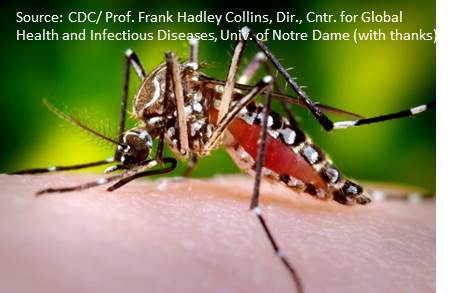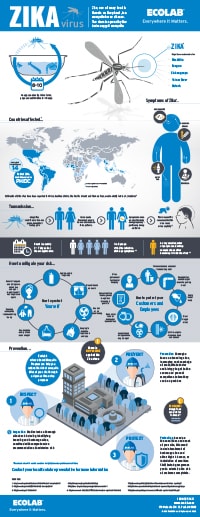
Zika Virus
Zika virus is a mosquito-borne virus transmitted primarily by the bite of the mosquito, Aedes aegypti. This species of mosquito also can transmit the viruses that cause dengue and chikungunya. Outbreaks of Zika virus have been reported in Africa, Southeast Asia, the Pacific islands and the Americas, most notably in Brazil.
Aedes aegypti mosquito
WHAT IS ZIKA VIRUS?
Zika virus is a mosquito-borne virus transmitted primarily by the bite of the mosquito, Aedes aegypti. This species of mosquito also can transmit the viruses that cause dengue and chikungunya1,2. Outbreaks of Zika virus have been reported in Africa, Southeast Asia, the Pacific islands and the Americas, most notably in Brazil2.
WHAT ARE THE SYMPTOMS?
About one in five people infected with Zika virus become ill. Symptoms include acute onset of mild fever, reddening of the skin, joint pain and conjunctivitis. Clinical illness is usually mild, with symptoms lasting for several days to a week. Severe disease requiring hospitalization is uncommon, and deaths from Zika virus are rare2.Maternal-fetal transmission of Zika virus has been documented throughout pregnancy. In the current outbreak in Brazil (2015/2016), a marked increase in the number of infants born with microcephaly has been reported3,4. Microcephaly is a birth defect where a baby’s head is smaller than expected when compared to babies of the same sex and age. Babies with microcephaly often have smaller brains that may not have developed properly. It is not known how many of these microcephaly cases are associated with Zika virus infection and what factors increase risk to the fetus4,5.
HOW IS IT TRANSMITTED?
Zika virus is transmitted from person-to-person through mosquito bites. Mosquitoes become infected with Zika virus when they feed on a person already infected with the virus. Infected mosquitoes can then spread the virus to other people through bites.HOW IS IT CONTROLLED?
There is no vaccine for Zika virus. The main preventive approaches are raising awareness of the risk factors, reducing exposure to mosquito bites and eliminating their breeding grounds. Wearing clothing that covers the skin, including long sleeves and pants, and the use of an insect repellent are highly recommended while outdoors. The use of window and door screens, and staying in buildings with air conditioning also is recommended.
Mosquitoes typically propagate by laying eggs in and near standing water, including buckets, bowls, animal dishes, flower pots and vases. Mosquitoes can lay several hundred eggs on the walls of water-filled containers. When water covers the eggs, they hatch and become adults in about a week. They are aggressive daytime biters and prefer to bite people for a blood meal2. They can live indoors and outdoors near people. To help reduce the number of mosquitoes inside and outside buildings, empty standing water from containers such as flowerpots or buckets, even old tires and trash2.
Until more is known, and out of an abundance of caution, the U.S. CDC recommends pregnant women in any trimester should consider postponing travel to the areas where Zika virus transmission is ongoing. In addition, women who are thinking about becoming pregnant should consult their healthcare provider before traveling to these areas and follow similar steps3.
WORLD HEALTH ORGANIZATION (WHO) DESIGNATION OF PUBLIC HEALTH EMERGENCY OF INTERNATIONAL CONCERN (PHEIC)
On February 1, 2016, the World Health Organization (WHO) met to discuss the clusters of microcephaly and/or neurological disorders that are suspected to be associated with Zika virus transmission in Brazil. The WHO declared Zika virus infection to be a Public Health Emergency of International Concern (PHEIC). The committee made a number of recommendations, including but not limited to 1) risk communications in countries with Zika should be enhanced, 2) vector control measures and appropriate personal protective measures should be aggressively promoted, 3) attention should be given to ensuring women of childbearing age and particularly pregnant women have the necessary information and materials to reduce risk of exposure and 4) pregnant women who have been exposed to Zika virus should be counseled and followed for birth outcomes6.
REFERENCES AND FURTHER INFORMATION
1. http://www.who.int/mediacentre/factsheets/zika/en/
2. http://www.cdc.gov/zika/index.html
3. http://emergency.cdc.gov/han/han00385.asp
4. https://www.cdc.gov/pregnancy/zika/
5. http://www.cdc.gov/ncbddd/birthdefects/microcephaly.html
6. http://www.who.int/mediacentre/news/statements/2016/1st-emergency-committee-zika/en/



